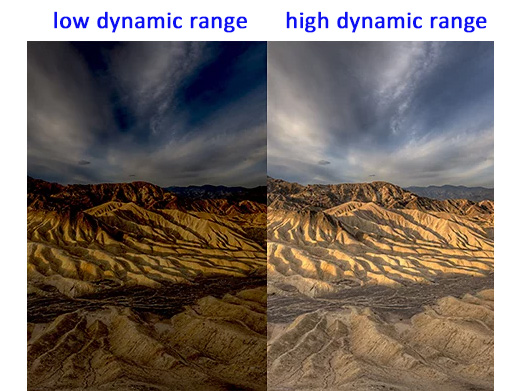Dynamic range is defined as the ratio of the maximum measurable light intensity to the minimum measurable light intensity. It can also be defined as the ratio of the number of pixel noise electrons when the pixel well capacity is saturated to the number of pixel noise electrons under no light conditions. The unit is decibel (dB).
In a more intuitive way, it refers to the camera’s ability to record light and dark details in a photo. The wider the dynamic range, the richer the details retained in the highlight and shadow areas of the photo. In general, dynamic range is an important indicator of a camera’s ability to capture light and dark details.
Here are some key points about dynamic range:
–Brightest area: The upper limit of the dynamic range usually corresponds to the maximum brightness that the camera sensor can record. If this brightness is exceeded, the picture will become pure white and lose highlight details (called highlight overflow).
–Darkest Area: The lower limit of the dynamic range refers to the lowest brightness that the sensor can record. If the brightness is lower than this range, the picture will become pure black and lose shadow details (called shadow blocking).
—Exposure Value (EV): For every 1EV increases, the brightness range increases. For example, a camera with a 14EV dynamic range will record 4EV more detail than a camera with a 10EV dynamic range.
—Bit depth: For example, a 14-bit RAW file can record more subtle brightness changes and has a wider dynamic range than an 8-bit JPEG file.
—HDR (High Dynamic Range): HDR is a post-processing technology that expands the dynamic range by taking multiple photos with different exposures and combining them into one. It emphasizes capturing more details under extreme lighting conditions.
—WDR (Wide Dynamic Range): WDR refers to the combined capabilities of camera hardware and software, which can capture details of both bright and dark areas in a single shot. It is usually applied to video streams or real-time images and is widely used in surveillance equipment.
—Sensor size and technology: Full-frame cameras generally have a wider dynamic range than compact sensor cameras because the pixels are larger and can capture more light. Newer generations of CMOS sensors generally have an even wider dynamic range.
—Signal-to-noise ratio: Sensors with high signal-to-noise ratios can better record subtle dark details, reduce noise, and thus improve dynamic range.
—Shooting Format: RAW format retains more dynamic range because it records the original data of the sensor. JPEG format loses some dynamic range due to compression and processing.
—ISO Settings: The lower the Image Sensor Optical Sensitivity (ISO), the higher the dynamic range (Dynamic Range), mainly because the sensor is better able to manage highlight and shadow details while reducing noise at low ISO. As ISO is increased, detail in highlights and shadows of the sensor may be lost, resulting in a reduction in dynamic range.

